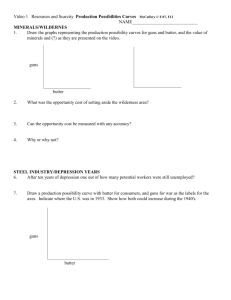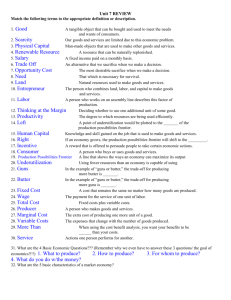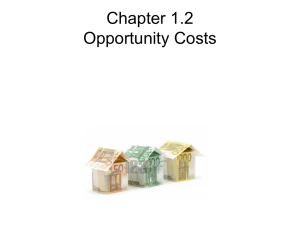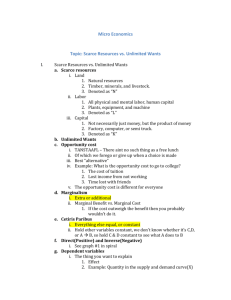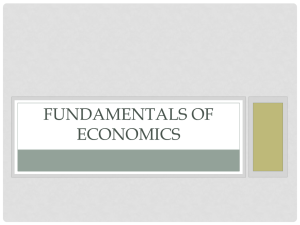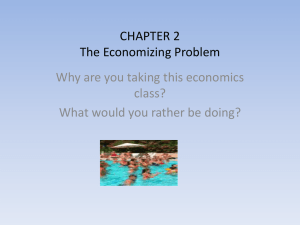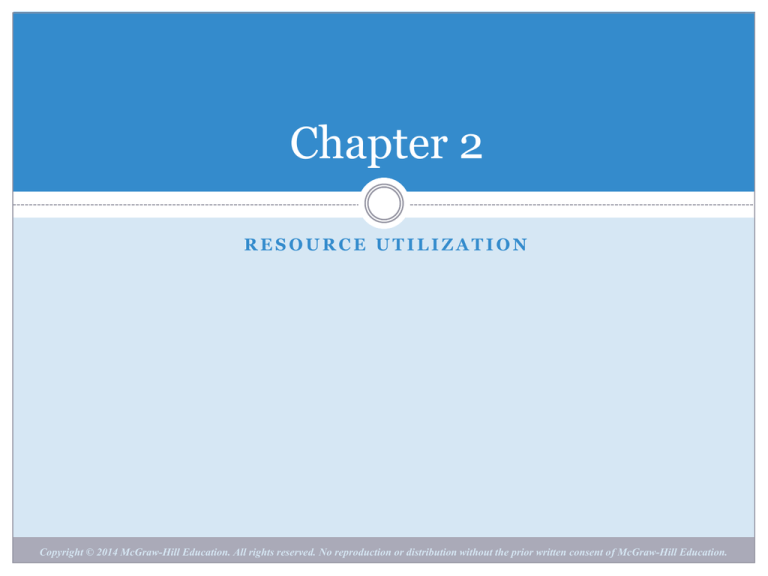
Chapter 2
RESOURCE UTILIZATION
Chapter 2
Copyright © 2014 McGraw-Hill Education. All rights reserved. No reproduction or distribution without the prior written consent of McGraw-Hill Education.
Learning Objectives
After this chapter you should be able to:
1.
2.
3.
4.
5.
6.
7.
8.
9.
Define economics.
Identify the central fact of economics and explain how it related to
the economic problem.
Name the four economic resources and explain how they are used
by the entrepreneur.
Explain and apply the concept of opportunity cost.
Describe and distinguish among the concepts of full employment,
full production, and underemployment.
Describe the concept of the production possibilities curve and how
it is used.
Identify and explain the three concepts upon which the law of
increasing costs is based.
Define and explain productive efficiency.
Identify and explain the factors which enable an economy to grow.
2-2
Economics Defined
• Economics studies the efficient allocation of the scarce
means of production toward the satisfaction of human
wants.
o
o
Efficiency, as a goal, emphasizes the need to maximize our
material output; given the amount of resources.
Means of production includes our resources and our
technological ability to use them to produce output.
•
•
o
Resources are the things used to produce goods and services.
These resources are scarce (limited).
Satisfaction of human wants is the purpose of an economy.
•
•
•
Economists assume people know their wants.
Definition does not distinguish between wants and needs.
Goods and services fulfill our material wants.
2-3
The Central Fact of Economics: SCARCITY
• This definition assumes that scarcity is the
fundamental economic problem:
o
There are never enough resources to produce all of the goods
and services that people want.
• Why is there an economic problem?
o The means of production (resources) are limited.
o Economists assume that human wants are unlimited.
• An economy is a system for organizing the
allocation of resources to produce and distribute the
goods and services that satisfy human wants.
o
The more efficient the economy is, the more wants we can
satisfy.
2-4
Four Economic Resources
• There are four categories of economic resources:
o
Land - natural resources
o
Labor - work
o
Capital - produced goods used to produce other goods and
services
o
Entrepreneurial ability - effort to organize the production
process
• In a market economy, each of these resources is
exchanged in markets for a type of income.
o
We sell our resources to earn income to purchase goods and
services to satisfy our wants.
2-5
Land Earns Rents
• Land (a broader meaning than our normal
understanding of the word).
o
Land includes natural resources like timber, oil, coal, iron ore,
soil, water, as well as the ground in which these resources are
found.
• How is land used in an economy?
o
o
Extraction of minerals (mining) and farming (agriculture)
It provides the site for factories, office buildings, shopping centers,
homes, etc.
• Owners of land receive rent.
o
o
Economic rent is money received from something that is given
by nature, rather than produced by human effort.
Rent is earned by establishing ownership over resources.
2-6
Labor Earns Wages.
• Labor:
o is work and time for which one is paid.
o involves human effort.
• Income received for one’s labor is called wages
and/or salaries
o
o
About two-thirds of the total resource cost is the cost of
labor.
Unpaid labor (housework, volunteer work) can also
contribute to the satisfaction of human wants.
2-7
Capital Earns Interest.
• Capital:
o
o
o
“human-made” goods used to produce other goods or services.
includes office buildings, stores, and factories (physical plant),
equipment, and software.
This is a different use of the term capital than when it means the
money a business uses to buy plant and equipment.
• The income owners of capital receive what is called
interest.
o
The purchase of new capital equipment is often funded through
loans, so the lender earns interest from its productivity.
2-8
Entrepreneur Ability Earns Profits.
• The entrepreneur:
o
o
o
o
sets up a business.
assembles the needed resources.
risks his/her own (or borrowed) money.
is central to the American economy.
• An entrepreneur earns a profit (or a loss) depending
upon his or her ability to run a business.
• There are over 30 million businesses in the U.S., most
are owned by entrepreneurs.
o
The vast majority work for themselves or have one or two
employees.
2-9
Questions for Thought and Discussion
• Why are the means of production scarce?
• The text has a quote by F.V. Meyer that says “Economics
is the science of greed.” What does he mean? Do you
agree or disagree with the quote?
• Which is the only category of resources that cannot be
increased over time?
• What is the difference between an entrepreneur and an
inventor?
2-10
Our Economic Problem Revisited
• Our economic problem is that we have limited
resources available to satisfy relatively unlimited
wants.
• There are NOT enough resources to produce
everything that everyone wants.
• Therefore, CHOICES must be made!
• The wood used to build a table cannot be used to make paper.
• The time a nurse spends filling out forms cannot be used in
patient care.
2-11
Opportunity Cost: A Fundamental Concept in
Economics
• Opportunity cost is the foregone value of the next
best alternative.
o
The value of things we give up (our second-best choice).
• People weigh the costs and benefits of various
options, including opportunity costs.
o
Economists assume that we choose the option we find more
valuable.
• In the economic world, “both” is not an admissible
answer to a choice of “which one.”
2-12
Choosing the Highest Valued Alternative
•
Because time is linear, we must make choices. Here are your
options:
o
o
o
o
•
spend time on social networking site.
play video games.
go to movies with friends.
study economics.
Whichever option is chosen, you will miss the value of the other
options.
o
o
o
If you go to the movie with friends, the direct cost is the movie ticket and
any transportation costs.
The opportunity cost is the value of the alternatives use of your time (for
example, the benefit of the improvement in your grade from studying).
Opportunity cost may or may not have a dollar value. But you implicitly
place a value when you make a decision.
2-13
You inherit $40,000.
Two choices: Buy your dream car or go to college.
Suppose you bought the car (paid $40,000):
What was the value of the
foregone option?
College graduate (lifetime earnings)
$1,300,000
High School graduate (lifetime earnings)
$800,000
Opportunity Cost
$500,000
2-14
Businesses and Government Face Also
Opportunity Costs.
• A large corporation has to choose between using
profits to pay shareholder dividends (boosting stock
value) or to purchase additional capital equipment
(which might increase profits at a later date).
• A small store has to choose which items get more
shelf space and which get less shelf space.
• Governments have to choose how much to spend on
education, military, food inspections, environmental
protection, medical research, etc.
• Some local governments are not paving local roads
so they do not have to raise taxes on residents.
2-15
Questions for Thought and Discussion
• Do Bill Gates and other wealthy persons face
scarcity? Do they have to weigh opportunity costs?
• The direct costs of the wars in Iraq and Afghanistan
have been approximately $150 per year. What are
some of the opportunity cost of the wars in Iraq and
Afghanistan?
• What are the opportunity costs of raising taxes to
fund government programs? What are the
opportunity costs of lowering taxes?
2-16
Full Employment and Full Production
• Full employment is when a society’s human resources
are being used with maximum efficiency.
o
o
Generally, a 4 – 6% unemployment rate is considered full
employment.
There will always be a small percentage of the labor force who are
between jobs.
• Full Production is when a society’s resources are
being allocated in the most efficient manner possible.
o
o
Full production can include physical resources (land and capital)
and human resources (labor and entrepreneurial ability).
Generally, a 85–90% capacity utilization rate is considered full
production of a nation’s capital.
2-17
Underemployment of Resources
• Underemployment of resources lowers the
productive output of the nation as a whole.
o
o
o
o
It is an economic problem, not just a personal problem.
Unemployment and low capacity utilization mean that
society is not allocating its resources efficiently in order to
maximize output.
An unemployment rate greater than 5% is considered
underemployment of our labor resources.
A capacity utilization rate less than 85% is considered
underemployment of our capital resources.
• Underemployment of resources occurs during
recessions.
2-18
Employment Discrimination Causes
Underemployment of Society’s Resources.
• Employment discrimination excludes members of
particular groups from particular jobs.
o
o
Society loses out when people are kept from being fully
productive.
Discrimination has diminished but has not been eliminated
entirely.
• Example: African Americans were kept out of major
league baseball until 1947.
o
o
Great baseball players like Satchel Paige played in the
separate Negro Leagues.
Society lost generations of contributions to records in Major
League Baseball.
2-19
The Production Possibilities Curve
• The Production Possibilities Curve represents our economy
at:
o
o
full employment.
full production.
• Productive efficiency occurs only when we are operating
on the production possibilities curve.
o
Productivity efficiency means that the output of one good
cannot be attained with out reducing the output of some other
good.
• Guns versus Butter example focuses on government’s
choice between military spending or spending on social
programs.
o
Remember: businesses and consumers face trade-offs too!
2-20
The Production Possibilities Curve
•
Points A, B, C, D, E, and F are
efficient with full employment
and full production.
•
Points X, Y, and Z are points
where economy is producing
below efficiency since either
capital is being under utilized or
the workforce is underemployed.
You can produce more guns
without sacrificing butter, or
vice versa.
•
Any point above the production
possibility curve, such as W, is
not achievable.
2-21
Production Possibilities Curve
Hypothetical Production
Schedule
Point
Units of
Butter
Units of
Guns
A
15
0
B
14
1
C
12
2
D
9
3
E
5
4
F
0
5
This Production Possibilities Curve
shows the range of possible
combinations of guns and butter
extending from 15 units of butter
and no guns at point A to 5 units of
guns and no butter at point F
2-22
Production Possibilities Curve
Hypothetical Production
Schedule
Point
Units of
Butter
Units of
Guns
A
15
0
B
14
1
C
12
2
D
9
3
E
5
4
F
0
5
Had to give up 1
unit of butter
•
•
When you are on the curve,
to get more of one thing you
have to give up some of the
other thing.
The opportunity cost of
gaining 1 unit of guns was 1
unit of butter
2-23
Law of Increasing Costs
•
As we shift from butter to guns,
we have to give up increasing
units of butter for each
additional unit of guns.
•
Law of Increasing Cost: As the
output of one good expands, the
opportunity cost of producing
additional units of this good
increases.
•
You give up fewer units of butter
to get 1 unit of guns up top.
From A to B you give up 1 unit of
butter to get 1 unit of guns.
•
You give up more units of butter
to get 1 unit of guns at the
bottom. From E to F you have to
give up 5 units of butter.
2-24
Questions for Thought and Discussion
• Explain how unemployment and discrimination are
problems for society as a whole, not just those
individuals who experience it. Give an example that
was not mentioned in your text.
• Explain how the concept of opportunity costs is
illustrated on the Production Possibilities Curve.
• In the Law of Increasing Costs, are we talking about
direct costs or opportunity costs increasing as we
produce more of one good or service?
2-25
Economic Growth
• Economic growth enables a society to produce more
guns AND more butter – or whatever goods and
services are allocated resources.
• What causes economic growth?
o
More or better trained labor
• More or improved plant and equipment (capital)
• Technological change (new fertilizer, shift from typewriter to
computer)
• Economic growth can be illustrated by a new
Production Possibilities Curve.
o
The curve moves to up and to the right
2-26
Economic Growth Illustrated
PPC
PPC after
economic growth
PPC after
more growth
2-27
Investing in Future Growth
Look! The axes
have new labels!
•
•
Note that investment in capital equipment today can lead to economic growth in the future.
Choosing Point B in Year 1 gives us greater production possibilities in the future than
choosing Point A.
2-28
Questions for Thought and Discussion
• Given limited resources, is growth always good?
o Why do most mainstream economists embrace growth?
• Is our economy in a period of full employment and
full production? What are the implications for you
when you look for a job after college?
• Choose a trade-off between any two goods or
services and illustrate it on a Production
Possibilities Curve. Try to explain how the Law of
Increasing Costs would operate as you move along
the curve.
• Does the PPC move out in a recession year?
2-29

